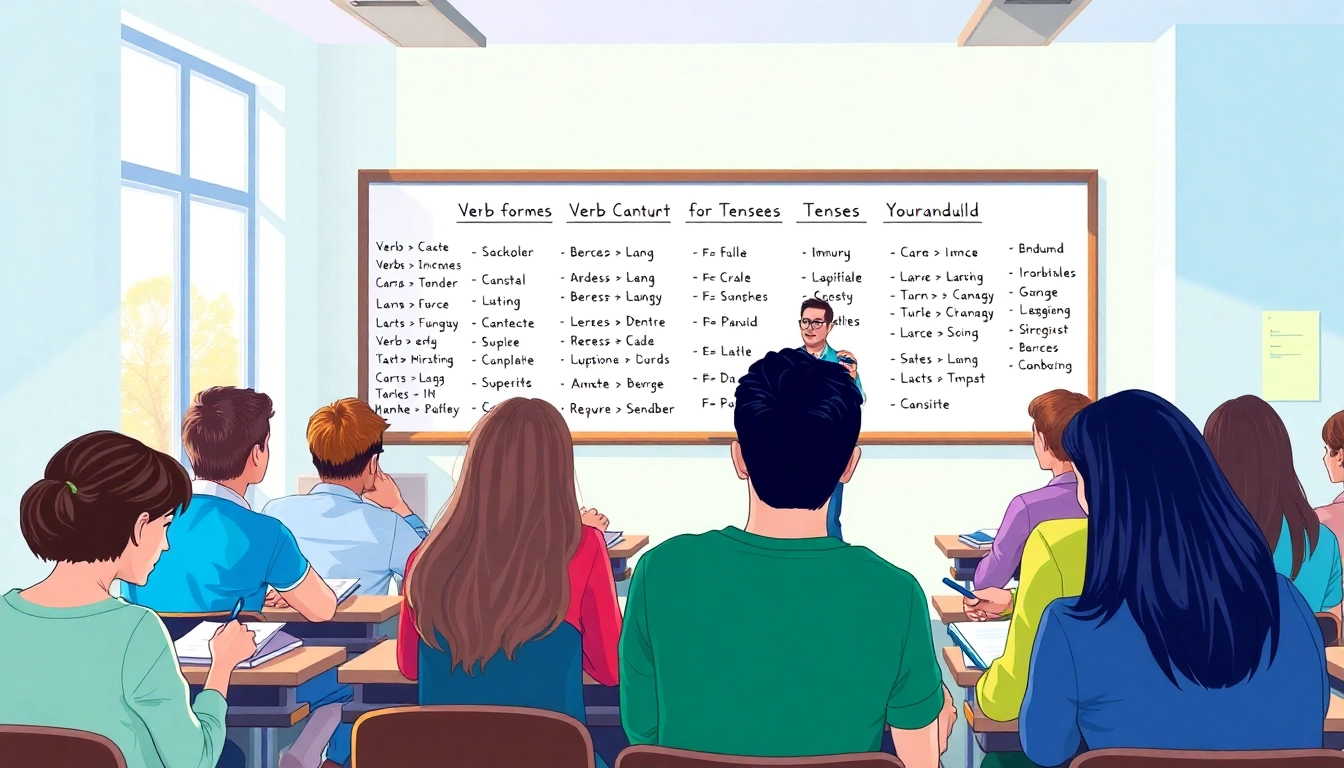Understanding Conjugation: The Basics
What is Conjugation?
Conjugation is a fundamental concept in grammar that refers to the systematic modification of verbs to reflect various aspects such as tense, mood, voice, and person. This process allows us to convey different meanings and nuances in our speech and writing. For instance, taking the base form of a verb, “to run,” one can create different forms like “ran” (past tense), “running” (present participle), and “will run” (future). The ability to conjugate verbs correctly is essential for effective communication in any language.
Importance of Conjugation in Language
Understanding conjugation is vital for several reasons. Firstly, it enhances clarity in communication, as conjugated forms can indicate when an action occurred (past, present, or future). Additionally, conjugation allows speakers to express complex ideas, conditions, and relationships. For instance, by employing various moods and tenses, one can convey not only the timing of actions but also their certainty or hypothetical nature. As such, mastering conjugation is key to achieving fluency in any language. For further exploration of this subject, consider visiting Conjugation resources that provide extensive practices and tools.
Diversity in Conjugation Across Languages
The approach to conjugation can vary dramatically across different languages. For example, languages like English primarily rely on auxiliary verbs and a relatively simple system of conjugation compared to highly inflected languages like Latin or Russian. In these more complex systems, a verb can change form to denote not just tense but also the subject’s gender, number, and case. This diversity in conjugation practices showcases the rich tapestry of linguistic expression and underlines the importance of understanding each language’s specific system to communicate effectively.
Types of Conjugation Explained
Regular vs. Irregular Verbs
In English and many other languages, verbs can be categorized into regular and irregular verbs, each adhering to different conjugation patterns. Regular verbs follow a consistent pattern: typically, adding ‘-ed’ for past tense and ‘-ing’ for present participle. For instance, “to walk” becomes “walked” and “walking.” In contrast, irregular verbs do not follow standard rules and can vary significantly in their forms. Common examples include “to go,” which becomes “went” in the past tense, and “to be,” which has the present forms “am,” “is,” and “are,” and the past forms “was” and “were.” Understanding these differences is crucial for anyone learning to conjugate verbs accurately.
Active and Passive Conjugation
Active and passive voice is another layer in the complexity of verb conjugation. In active voice, the subject performs the action (e.g., “The cat chased the mouse”), while in passive voice, the subject receives the action (e.g., “The mouse was chased by the cat”). Depending on the context, one may choose to use either voice for stylistic reasons or to emphasize particular components of the sentence. The choice between active and passive constructions often influences the clarity and directness of language.
Infinitive Forms and Their Uses
The infinitive form of a verb is its base or dictionary form, often preceded by “to,” such as “to run,” “to eat,” or “to be.” Infinitives serve as essential building blocks within a sentence, used as nouns, adjectives, or adverbs. They can express purpose (e.g., “I went to the store to buy groceries”) or function as the subject of a sentence (e.g., “To run is my passion”). Understanding how to use infinitives effectively can greatly enhance one’s ability to construct more articulate and diverse sentences.
Conjugation Patterns by Language
Conjugation in English
English conjugation involves various tenses, including present simple, past simple, future simple, present perfect, and more. Regular verbs follow predictable patterns, while irregular verbs require memorization due to their unique forms. English also employs modal verbs (can, could, may, might, etc.) that modify the main verb to express possibility, ability, necessity, or permission. The clear distinction of subject-verb agreement is also pivotal in proper conjugation; for instance, in the present simple tense, “He runs,” whereas “They run.” This aspect is essential for attaining grammatical accuracy in spoken and written English.
Conjugating Spanish Verbs
Spanish verb conjugation is significantly more complex, with distinct endings for each subject pronoun across various tenses. The three main types of Spanish verbs are categorized by their endings: -ar, -er, and -ir verbs. For example, the verb “hablar” (to speak) is conjugated as “hablo” (I speak), “hablas” (you speak), and “habla” (he/she speaks). The past tense includes additional forms like pretérito and imperfecto, each serving unique temporal and aspectual functions. Mastery of these conjugation rules is critical for effective communication in Spanish.
French Verb Conjugation Essentials
French conjugation, much like Spanish, features a wide array of endings based on subject pronouns and spectrums of tenses and moods. Regular verbs fall into three groups: -er (parler), -ir (finir), and -re (vendre), while a multitude of irregular verbs exist. The conjugation for “parler” in the present tense demonstrates this: “je parle” (I speak), “tu parles” (you speak), and “il/elle parle” (he/she speaks). Tenses in French also include complexities with the subjunctive and conditional moods, allowing for nuanced expression of desires, hypotheses, and potential actions.
Practical Tips for Learning Conjugation
Effective Study Techniques
To master conjugation in any language, employing effective study techniques is essential. Begin by creating verb conjugation charts for both regular and irregular verbs, which serve as quick references. Flashcards can also prove beneficial, allowing for repeated practice and reinforcement of memory. Group study sessions can offer collaborative learning opportunities, where learners can practice conjugation with peers and gain confidence. Regularly using verbs in context—such as writing sentences or engaging in conversation—will help in solidifying understanding.
Utilizing Online Tools for Practice
Numerous online tools and resources cater specifically to learning conjugation. Websites and mobile applications provide exercises that cover various tenses across different languages, offering immediate feedback and progressive levels of difficulty. Engaging with interactive platforms can enhance learning by providing a gamified experience, making practice enjoyable. Additionally, online conjugators can serve as useful aids for checking conjugation forms when written practice leads to uncertainty.
Common Mistakes to Avoid
As learners engage with conjugation, several common pitfalls arise. One prevalent error is neglecting subject-verb agreement, which can lead to confusion in sentences. Ensuring that verbs correctly match their subjects in number and person is critical. Another common mistake involves mixing up regular and irregular verb patterns, leading to incorrect forms. Consistent practice and leveraging memory aids, such as mnemonics, can help avoid these issues. Lastly, many learners struggle with tenses, often confusing past and present forms. Regular review of tenses and their appropriate contexts will bolster one’s command of verb usage.
Advanced Concepts in Conjugation
Subjunctive Mood and Its Usage
The subjunctive mood is often a challenging concept for learners, as its use varies considerably among languages. In English, it tends to appear in clauses expressing wishes, demands, or hypotheticals—examples include “I wish he were here” or “It is essential that she speak at the conference.” However, in languages like Spanish and French, the subjunctive is more prevalent, frequently invoked in verbal expressions of doubt, desires, or uncertainty. Mastering the subtleties of the subjunctive can significantly enhance one’s proficiency in expressing nuanced thoughts.
Future and Conditional Conjugation Explained
Future and conditional tenses allow speakers to discuss actions that have yet to occur or that depend on certain conditions. In English, the future tense is often formed with “will” or “going to,” as in “I will travel” or “I am going to swim.” The conditional tense expresses scenarios that are imagined or contingent on specific conditions, such as “I would go if I had time.” Spanish and French similarly incorporate distinct conjugation rules for future and conditional contexts, such as “hablaré” (I will speak) and “je parlerais” (I would speak) respectively. Understanding these tenses supports richer communication regarding potential events and situations.
Exploring Theories of Grammatical Conjugation
Theories surrounding grammatical conjugation encompass various linguistic and cultural aspects of language use and development. Some theories suggest that natural language evolution has shaped verb conjugation patterns across societies, reflecting differentiations in thought processes and cultural practices. Additionally, the application of generative grammar theorizes that underlying rules govern conjugation, which can be applied universally across languages, while others emphasize the importance of social context in language structure. Examining these theories can offer profound insights into not just how languages operate, but why they develop as they do in different cultural landscapes.








